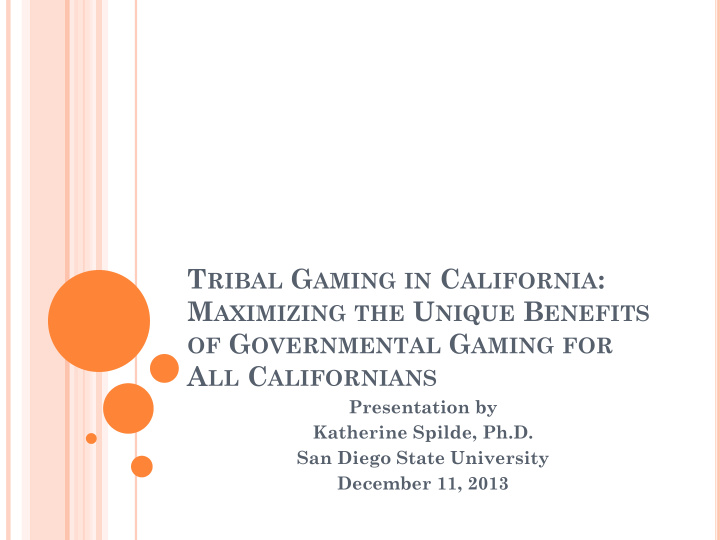



T RIBAL G AMING IN C ALIFORNIA : M AXIMIZING THE U NIQUE B ENEFITS OF G OVERNMENTAL G AMING FOR A LL C ALIFORNIANS Presentation by Katherine Spilde, Ph.D. San Diego State University December 11, 2013
T WENTY YEARS OF RESEARCH DATA
P OLICY M ATTERS “Lands of Opportunity: Social and Economic Effects of Tribal Gaming on Localities Inter-disciplinary Research Project Sponsored by the Pechanga Band of Luise ň o Indians and UCR’s California Center for Native Nations Methodology: 1. Analysis of 1990 and 2000 U.S. Census Data for California Tribal Governments 2. California Nations Institutional Development and Intergovernmental Relations 3
“P OLICY M ATTERS ” M ETHODS & F INDINGS Analysis of 1990 and 2000 U.S. Census Data, Comparing: CA Tribes pre- and post-gaming; CA gaming and non-gaming tribes; CA Tribes to rest of U.S. Tribes; CA Tribes to all U.S. Survey of Tribal and local governments in California 4
P RIMARY F INDINGS Impacts of Indian Gaming in California are directly related to two unique features of the gaming enterprises: Tribal Government ownership 1. Location on existing tribal lands 2. These features place a natural limit on casino gaming in California and distribute benefits to poorest regions of the state. 5
S ECONDARY F INDINGS Establishment of Indian Gaming in California has had beneficial impacts on: 1. Income Levels 2. Poverty Rates 3. Employment 4. Educational attainment On and near reservations! 6
“P OLICY M ATTERS ” C ONCLUSIONS Lack of a gaming compact in 1990’s resulted in uneven development of Indian gaming and increased inequalities between gaming and non-gaming tribes in California; This inequality was addressed by the 2000 tribal-state compact through the Revenue Sharing Trust Fund (RSTF); Survey research on tribal governments in 2005 suggested that payments to the RSTF have been invested in ways that address these inequalities and that Tribes without gaming have expanded services at a rate similar to that of Tribes with gaming. Benefits of Indian gaming have been substantial for tribal members and their neighbors but it will take more time for them to be fully realized; Large gaps remain between conditions on Indian reservations in California and those enjoyed by other Americans; National data suggests that it would take at least 50 years for Indian Country to “catch up” even at current rate of growth 7
Real average income per capita American Indians on Reservations 25000.00 $21,587 $19,374 20000.00 15000.00 $12,526 1990 2000 $9,450 10000.00 $8,778 $8,247 $8,183 $8,080 $7,220 $6,148 5000.00 0.00 Indians US Indians CA Indians US Indians CA (except CA) (except CA) Non-Gaming Gaming Total U.S. • In 1990, CA gaming and non-gaming reservations were similar 8 • By 2000, fastest growth in CA gaming reservations (55% growth versus 15%) • In 2000, tribal incomes remained only 53% of national average
P OVERTY R ATES R EMAINED H IGH IN 2000 Families in Poverty (in percentage) 40 35.9 35 29.9 29.7 30 26.1 25 1990 20 2000 15 10.5 10 9.3 9.2 10 5 0 Non- Gaming California U.S. Gaming 9
B ETWEEN 1990 & 2000, MEDIAN REAL FAMILY INCOME GREW SIGNIFICANTLY FASTER IN TRACTS CLOSE TO GAMING RESERVATION THAN IN THE TRACTS NOT CLOSE TO GAMING RESERVATIONS … Median real family income (in constant 2000 $) in 1990 & 2000, by proximity of tract to gaming reservation 70,000 1990 2000 1990-2000 increase $58,132 60,000 $48,578 50,000 $46,255 40,000 $32,515 30,000 % increase in italics 20,000 $16,063 $11,877 10,000 55.1% 32.9% 0 No Yes Whether tract within 10 miles of gaming reservation? 10
S PILLOVER E FFECTS OF I NDIAN G AMING IN CA UCR’s main finding in Policy Matters is that Indian gaming in California on reservation lands has brought income and employment benefits not just to the residents of gaming reservations but also to the communities and households residing in close vicinity of the gaming reservations. These spillover effects are directly related to placing tribal casinos on reservations lands as supported in the Indian Gaming Regulatory Act (IGRA) and the investment of funds by tribal governments 11
C HANGES FROM 2000-2010: S PILLOVER E FFECTS G ROW Significant gains for American Indians on reservations and those who live nearby (Incomes in communities near reservations with gaming grew significantly (7-11%) more than those more than 5-10-20 miles away) American Indian per-capita income grew to $18,361 by 2010 (23% increase since 2000) This growth helped close the gap with the US Average ($26,893) although these gains are also due to the drop in national income due to the recession (3% decrease since 2000) 12
A VERAGE PER CAPITA INCOME In communities near Indian reservations with gaming, average income for Californians of all ethnicities rose more in the 1990s and fell less in the 2000s than it did for those tracts that were more than 10 miles from a reservation with gaming These impacts result from the fact that most American Indian reservations in California, even the more prosperous ones, are generally located in the poorest counties and tracts in the state . 14
R ECENT P UBLICATIONS FROM SITG
15 Y EARS OF R ESEARCH ON T RIBAL G AMING : T HANK Y OU S YCUAN B AND OF THE K UMEYAAY N ATION FOR YOUR S UPPORT ! January, 2013: Western Indian Gaming Conference at Morongo Casino April, 2013: National Indian Gaming Association in Phoenix, AZ May, 2013: International Conference on Gambling and Risk Taking in LV August, 2013: Oklahoma Indian Gaming Association in OKC September, 2013: Global Gaming Expo in LV November, 2013: 21 Arizona Indian Gaming Association
Recommend
More recommend